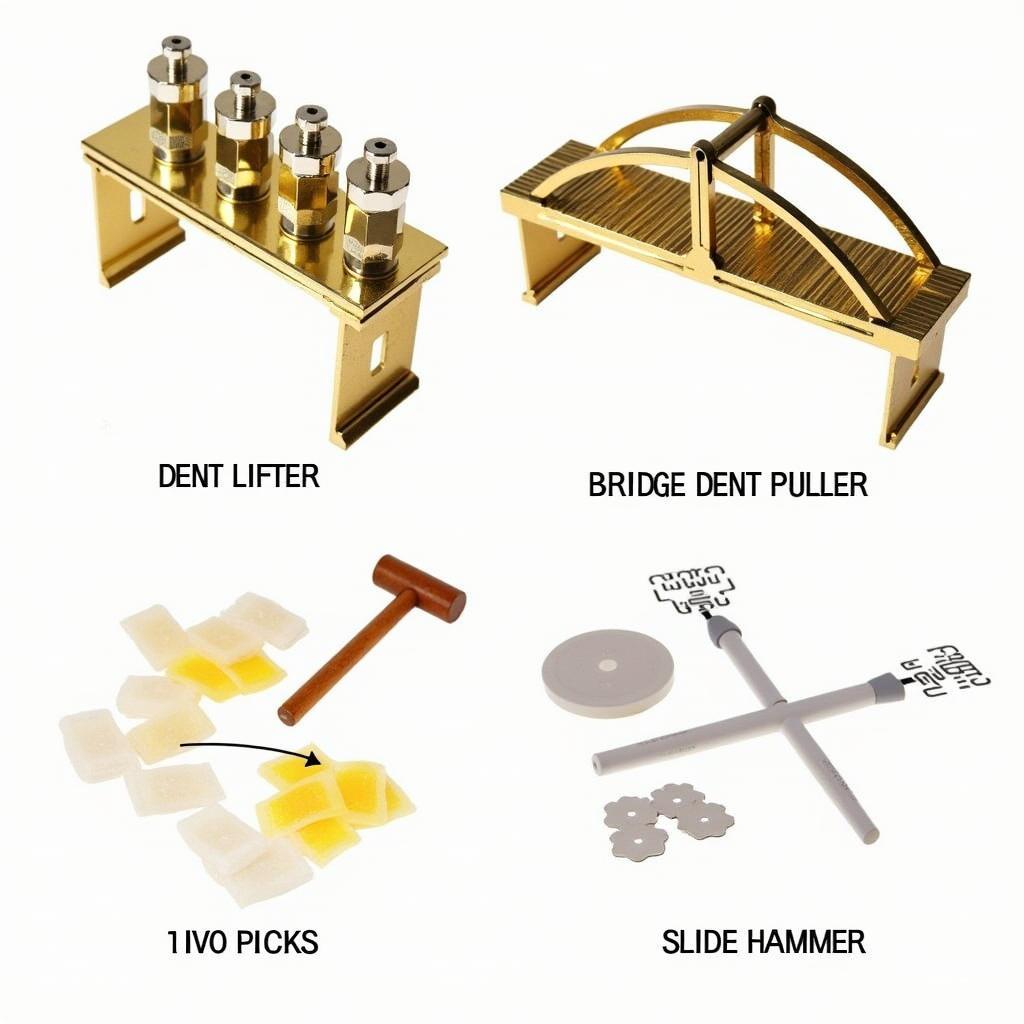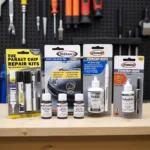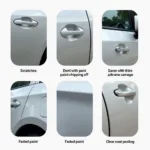Car body dent repair pullers are essential tools for anyone looking to fix minor dents and dings on their vehicle. Whether you’re dealing with hail damage, door dings, or other small dents, a car body dent repair puller can help you achieve professional-looking results at a fraction of the cost. This guide will provide you with everything you need to know about these versatile tools, from understanding the different types to mastering the techniques for seamless dent removal.
Types of Car Body Dent Repair Pullers
There are several types of dent pullers available, each with its own advantages and ideal use cases. Choosing the right type depends on the size, location, and severity of the dent you’re tackling.
Bridge Dent Pullers
As their name suggests, bridge dent pullers utilize a bridge-like structure with two or more legs that rest on the undamaged area surrounding the dent. By tightening a screw mechanism, the bridge pulls up the center of the dent, restoring the panel to its original shape. These pullers are particularly effective on larger dents with a defined center point.
Glue-Based Dent Pullers
Glue-based dent pullers, also known as glue pullers or hot glue guns, offer a less invasive approach to dent removal. They work by adhering a pulling tab to the center of the dent using specialized hot glue. Once the glue sets, you use a slide hammer or similar pulling device to gently pull the dent outward. These pullers are ideal for smaller dents and areas with limited access.
Lever Dent Pullers
Lever dent pullers feature a lever mechanism that provides leverage to extract dents. By positioning the base of the lever on a solid surface and hooking the pulling arm under the dent, you can apply controlled force to pull the dent outward. Lever dent pullers are suitable for dents located on edges or near body lines.
How to Use a Car Body Dent Repair Puller Effectively
While the specific steps may vary depending on the type of dent puller you choose, the general process involves the following:
-
Clean the Damaged Area: Before you begin, thoroughly clean the dented area with soap and water to remove any dirt, debris, or wax. This ensures proper adhesion for glue-based pullers and allows you to assess the dent’s severity accurately.
-
Choose the Right Puller: Select the appropriate car body dent repair puller based on the size and location of the dent.
-
Position the Puller: Carefully position the dent puller according to its instructions. For bridge pullers, ensure the legs rest on the undamaged areas surrounding the dent. For glue-based pullers, attach the pulling tab to the center of the dent using the provided hot glue.
-
Apply Gradual Pressure: Slowly and steadily apply pressure to the dent puller. Avoid using excessive force, as this can damage the vehicle’s paint or metal.
-
Check Your Progress: Periodically check your progress as you pull the dent. You may need to reposition the puller or use a different pulling technique to achieve optimal results.
-
Repeat if Necessary: For deeper dents, you may need to repeat the process multiple times, gradually working the dent outward.
-
Finishing Touches: Once the dent is removed, inspect the area for any remaining imperfections. You can use a rubber mallet to gently tap down any high spots or use touch-up paint to address any minor paint chips.
Tips for Successful Dent Repair
-
Practice Makes Perfect: Start with practicing on scrap metal panels before attempting dent repair on your vehicle. This allows you to familiarize yourself with the tools and techniques without the risk of damaging your car.
-
Patience is Key: Dent repair takes time and patience. Avoid rushing the process, as this can lead to mistakes and unsatisfactory results.
-
Don’t Be Afraid to Seek Professional Help: If you’re unsure about any aspect of the dent repair process or dealing with a severe dent, it’s always best to consult a professional car body repair shop.
Conclusion
Car body dent repair pullers offer a cost-effective and convenient solution for removing minor dents and dings from your vehicle. By understanding the different types of pullers available and following the proper techniques, you can achieve professional-looking results from the comfort of your own garage. Remember to prioritize safety, patience, and practice for the best possible outcome. If you’re looking for a specific type of car body repair, you can find more information on our dedicated pages, such as car body repair kit sucktion, car body repair college courses glasgow, or car body repair bicester.



